Team Development Plan Report: Analyzing Team Dynamics and Strategies
VerifiedAdded on 2022/09/14
|7
|1714
|29
Report
AI Summary
This report presents a comprehensive team development plan, focusing on assessing the current situation of a team of ten diverse members. It analyzes declining commitment and engagement, conflicts, and role inefficiencies. The report evaluates communication strategies, including both traditional and modern methods like emails and social media, and identifies effective motivational techniques such as setting SMART goals and fostering an open, participative environment. Factors beyond the leader's control, such as macroenvironmental changes, costs, and personal issues, are also identified. The report proposes a future state of a collaborative team and recommends a transformational leadership approach to inspire team members toward common goals. The plan emphasizes effective communication, conflict management, and continuous improvement to enhance team performance and achieve set objectives.
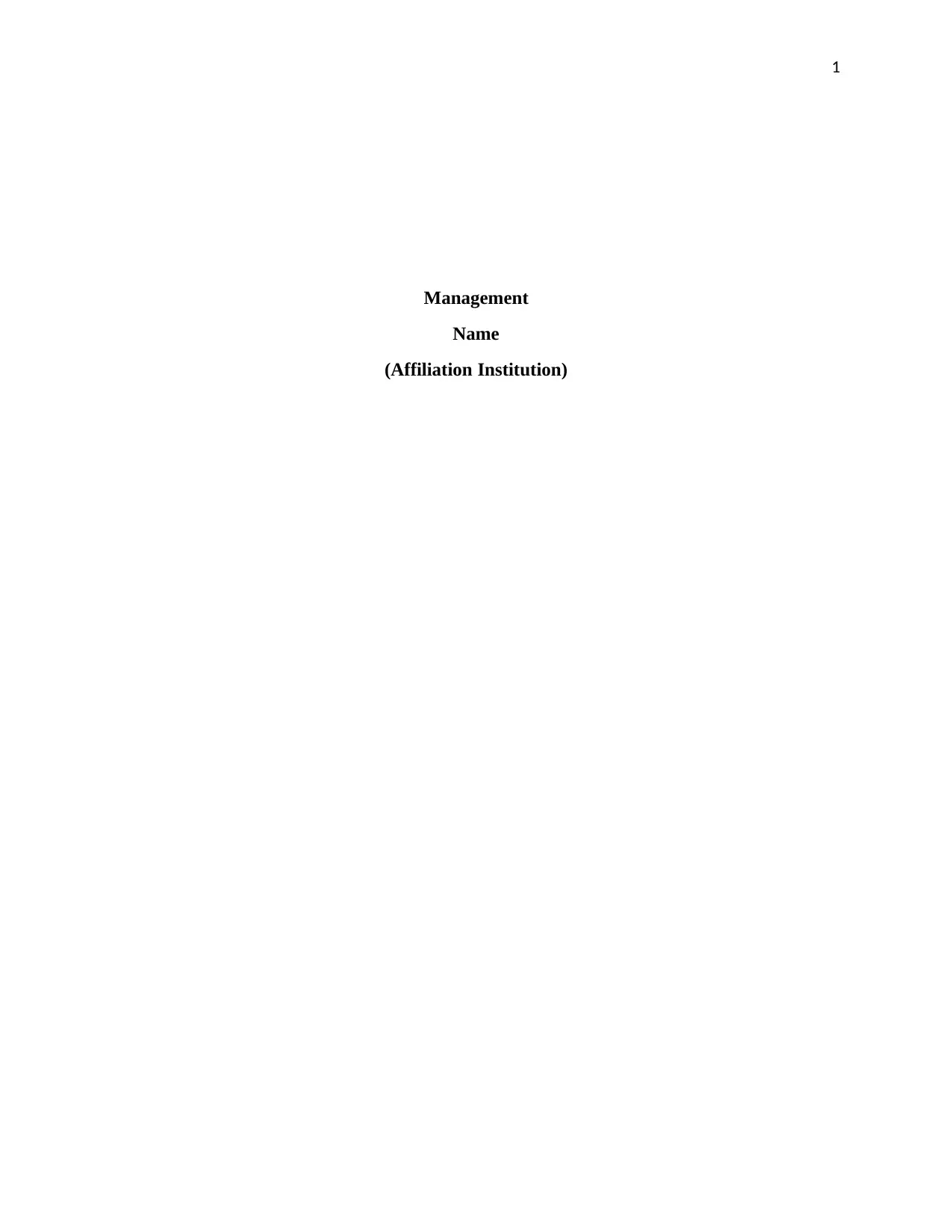
1
Management
Name
(Affiliation Institution)
Management
Name
(Affiliation Institution)
Paraphrase This Document
Need a fresh take? Get an instant paraphrase of this document with our AI Paraphraser
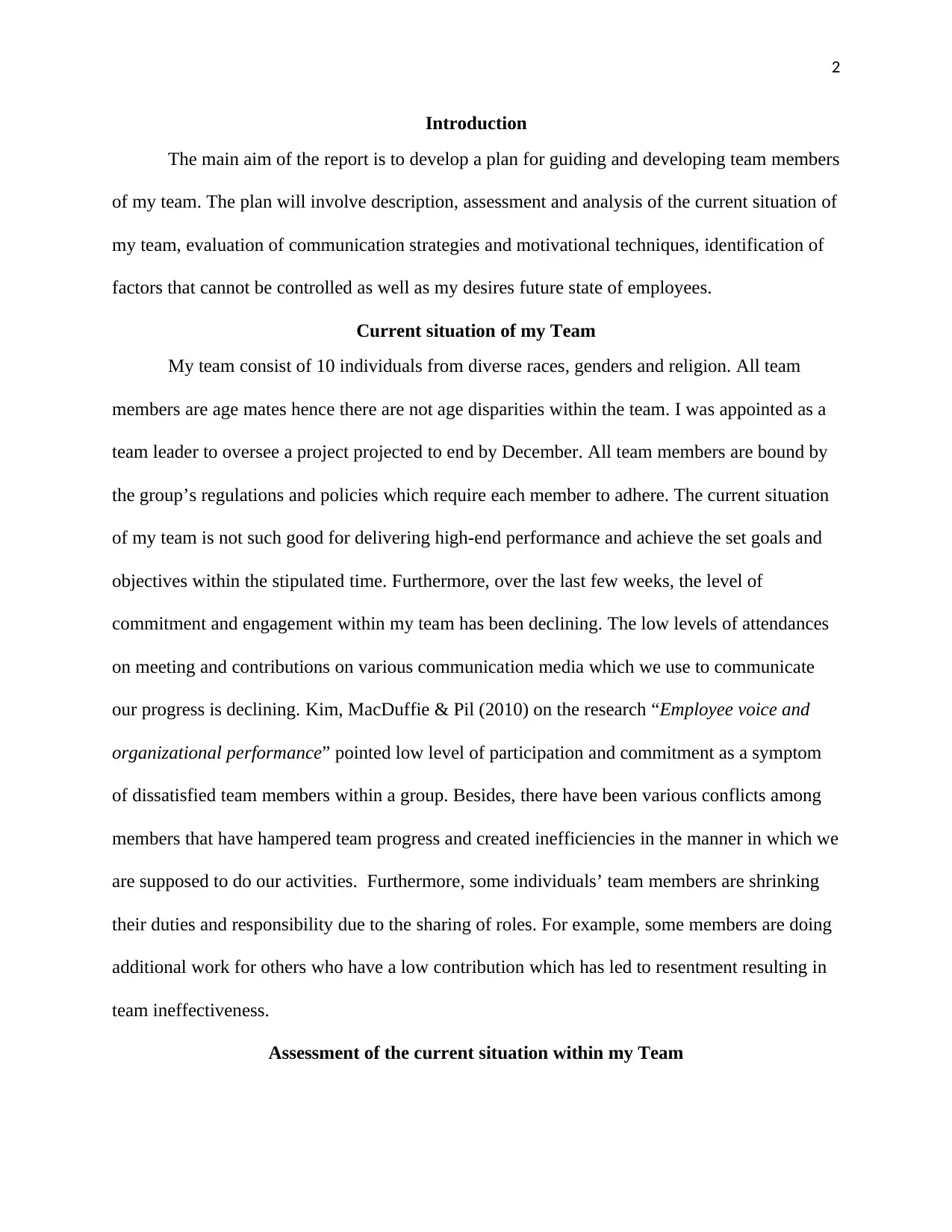
2
Introduction
The main aim of the report is to develop a plan for guiding and developing team members
of my team. The plan will involve description, assessment and analysis of the current situation of
my team, evaluation of communication strategies and motivational techniques, identification of
factors that cannot be controlled as well as my desires future state of employees.
Current situation of my Team
My team consist of 10 individuals from diverse races, genders and religion. All team
members are age mates hence there are not age disparities within the team. I was appointed as a
team leader to oversee a project projected to end by December. All team members are bound by
the group’s regulations and policies which require each member to adhere. The current situation
of my team is not such good for delivering high-end performance and achieve the set goals and
objectives within the stipulated time. Furthermore, over the last few weeks, the level of
commitment and engagement within my team has been declining. The low levels of attendances
on meeting and contributions on various communication media which we use to communicate
our progress is declining. Kim, MacDuffie & Pil (2010) on the research “Employee voice and
organizational performance” pointed low level of participation and commitment as a symptom
of dissatisfied team members within a group. Besides, there have been various conflicts among
members that have hampered team progress and created inefficiencies in the manner in which we
are supposed to do our activities. Furthermore, some individuals’ team members are shrinking
their duties and responsibility due to the sharing of roles. For example, some members are doing
additional work for others who have a low contribution which has led to resentment resulting in
team ineffectiveness.
Assessment of the current situation within my Team
Introduction
The main aim of the report is to develop a plan for guiding and developing team members
of my team. The plan will involve description, assessment and analysis of the current situation of
my team, evaluation of communication strategies and motivational techniques, identification of
factors that cannot be controlled as well as my desires future state of employees.
Current situation of my Team
My team consist of 10 individuals from diverse races, genders and religion. All team
members are age mates hence there are not age disparities within the team. I was appointed as a
team leader to oversee a project projected to end by December. All team members are bound by
the group’s regulations and policies which require each member to adhere. The current situation
of my team is not such good for delivering high-end performance and achieve the set goals and
objectives within the stipulated time. Furthermore, over the last few weeks, the level of
commitment and engagement within my team has been declining. The low levels of attendances
on meeting and contributions on various communication media which we use to communicate
our progress is declining. Kim, MacDuffie & Pil (2010) on the research “Employee voice and
organizational performance” pointed low level of participation and commitment as a symptom
of dissatisfied team members within a group. Besides, there have been various conflicts among
members that have hampered team progress and created inefficiencies in the manner in which we
are supposed to do our activities. Furthermore, some individuals’ team members are shrinking
their duties and responsibility due to the sharing of roles. For example, some members are doing
additional work for others who have a low contribution which has led to resentment resulting in
team ineffectiveness.
Assessment of the current situation within my Team
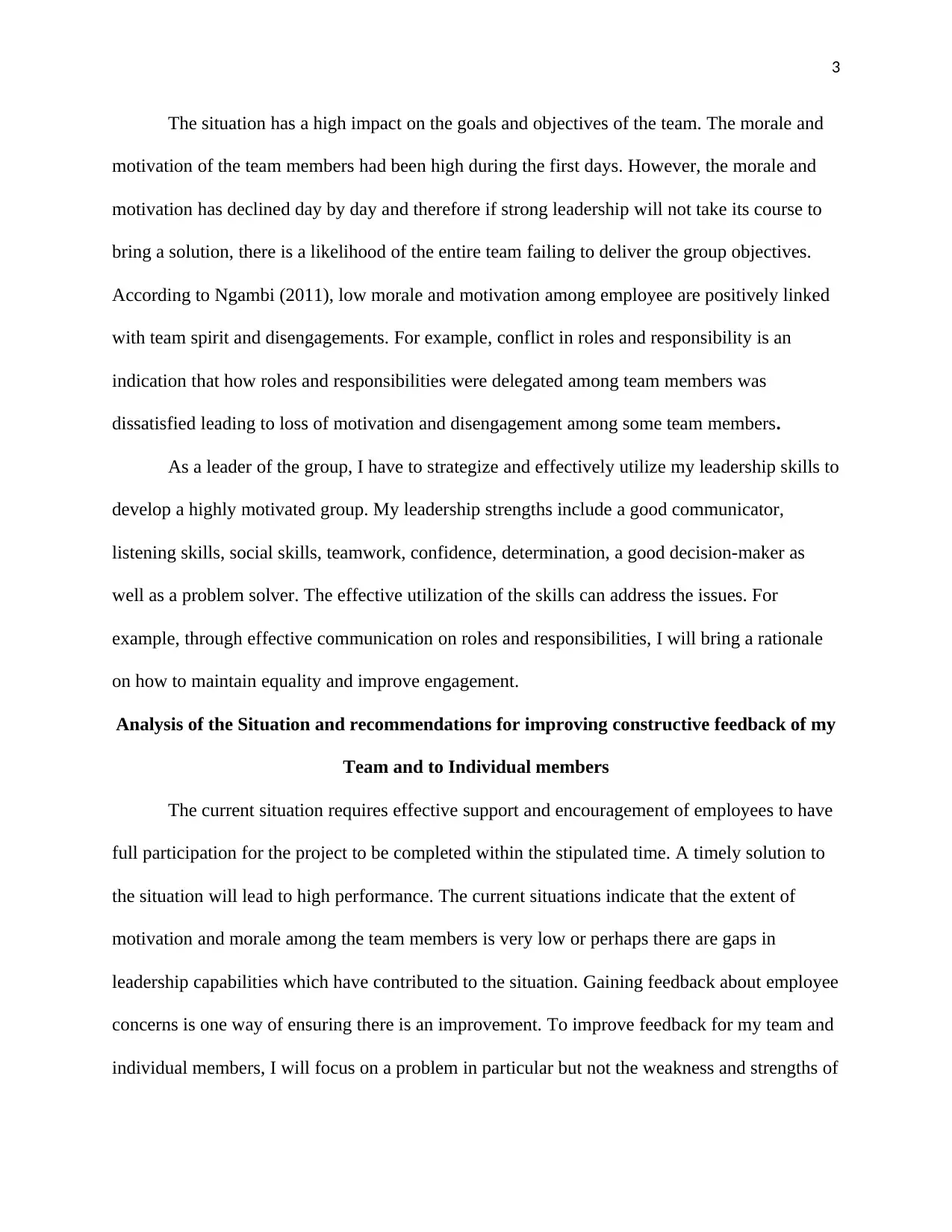
3
The situation has a high impact on the goals and objectives of the team. The morale and
motivation of the team members had been high during the first days. However, the morale and
motivation has declined day by day and therefore if strong leadership will not take its course to
bring a solution, there is a likelihood of the entire team failing to deliver the group objectives.
According to Ngambi (2011), low morale and motivation among employee are positively linked
with team spirit and disengagements. For example, conflict in roles and responsibility is an
indication that how roles and responsibilities were delegated among team members was
dissatisfied leading to loss of motivation and disengagement among some team members.
As a leader of the group, I have to strategize and effectively utilize my leadership skills to
develop a highly motivated group. My leadership strengths include a good communicator,
listening skills, social skills, teamwork, confidence, determination, a good decision-maker as
well as a problem solver. The effective utilization of the skills can address the issues. For
example, through effective communication on roles and responsibilities, I will bring a rationale
on how to maintain equality and improve engagement.
Analysis of the Situation and recommendations for improving constructive feedback of my
Team and to Individual members
The current situation requires effective support and encouragement of employees to have
full participation for the project to be completed within the stipulated time. A timely solution to
the situation will lead to high performance. The current situations indicate that the extent of
motivation and morale among the team members is very low or perhaps there are gaps in
leadership capabilities which have contributed to the situation. Gaining feedback about employee
concerns is one way of ensuring there is an improvement. To improve feedback for my team and
individual members, I will focus on a problem in particular but not the weakness and strengths of
The situation has a high impact on the goals and objectives of the team. The morale and
motivation of the team members had been high during the first days. However, the morale and
motivation has declined day by day and therefore if strong leadership will not take its course to
bring a solution, there is a likelihood of the entire team failing to deliver the group objectives.
According to Ngambi (2011), low morale and motivation among employee are positively linked
with team spirit and disengagements. For example, conflict in roles and responsibility is an
indication that how roles and responsibilities were delegated among team members was
dissatisfied leading to loss of motivation and disengagement among some team members.
As a leader of the group, I have to strategize and effectively utilize my leadership skills to
develop a highly motivated group. My leadership strengths include a good communicator,
listening skills, social skills, teamwork, confidence, determination, a good decision-maker as
well as a problem solver. The effective utilization of the skills can address the issues. For
example, through effective communication on roles and responsibilities, I will bring a rationale
on how to maintain equality and improve engagement.
Analysis of the Situation and recommendations for improving constructive feedback of my
Team and to Individual members
The current situation requires effective support and encouragement of employees to have
full participation for the project to be completed within the stipulated time. A timely solution to
the situation will lead to high performance. The current situations indicate that the extent of
motivation and morale among the team members is very low or perhaps there are gaps in
leadership capabilities which have contributed to the situation. Gaining feedback about employee
concerns is one way of ensuring there is an improvement. To improve feedback for my team and
individual members, I will focus on a problem in particular but not the weakness and strengths of
⊘ This is a preview!⊘
Do you want full access?
Subscribe today to unlock all pages.

Trusted by 1+ million students worldwide
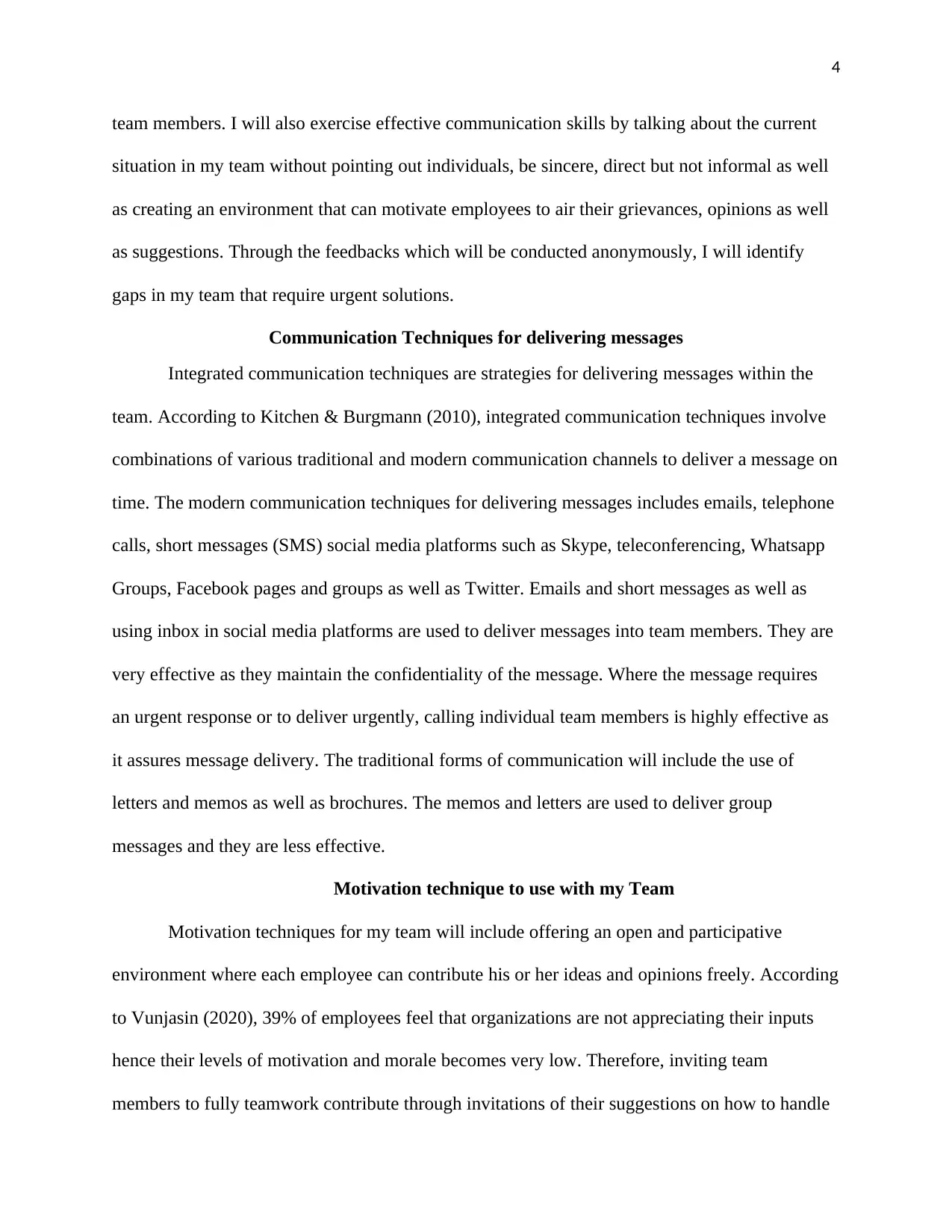
4
team members. I will also exercise effective communication skills by talking about the current
situation in my team without pointing out individuals, be sincere, direct but not informal as well
as creating an environment that can motivate employees to air their grievances, opinions as well
as suggestions. Through the feedbacks which will be conducted anonymously, I will identify
gaps in my team that require urgent solutions.
Communication Techniques for delivering messages
Integrated communication techniques are strategies for delivering messages within the
team. According to Kitchen & Burgmann (2010), integrated communication techniques involve
combinations of various traditional and modern communication channels to deliver a message on
time. The modern communication techniques for delivering messages includes emails, telephone
calls, short messages (SMS) social media platforms such as Skype, teleconferencing, Whatsapp
Groups, Facebook pages and groups as well as Twitter. Emails and short messages as well as
using inbox in social media platforms are used to deliver messages into team members. They are
very effective as they maintain the confidentiality of the message. Where the message requires
an urgent response or to deliver urgently, calling individual team members is highly effective as
it assures message delivery. The traditional forms of communication will include the use of
letters and memos as well as brochures. The memos and letters are used to deliver group
messages and they are less effective.
Motivation technique to use with my Team
Motivation techniques for my team will include offering an open and participative
environment where each employee can contribute his or her ideas and opinions freely. According
to Vunjasin (2020), 39% of employees feel that organizations are not appreciating their inputs
hence their levels of motivation and morale becomes very low. Therefore, inviting team
members to fully teamwork contribute through invitations of their suggestions on how to handle
team members. I will also exercise effective communication skills by talking about the current
situation in my team without pointing out individuals, be sincere, direct but not informal as well
as creating an environment that can motivate employees to air their grievances, opinions as well
as suggestions. Through the feedbacks which will be conducted anonymously, I will identify
gaps in my team that require urgent solutions.
Communication Techniques for delivering messages
Integrated communication techniques are strategies for delivering messages within the
team. According to Kitchen & Burgmann (2010), integrated communication techniques involve
combinations of various traditional and modern communication channels to deliver a message on
time. The modern communication techniques for delivering messages includes emails, telephone
calls, short messages (SMS) social media platforms such as Skype, teleconferencing, Whatsapp
Groups, Facebook pages and groups as well as Twitter. Emails and short messages as well as
using inbox in social media platforms are used to deliver messages into team members. They are
very effective as they maintain the confidentiality of the message. Where the message requires
an urgent response or to deliver urgently, calling individual team members is highly effective as
it assures message delivery. The traditional forms of communication will include the use of
letters and memos as well as brochures. The memos and letters are used to deliver group
messages and they are less effective.
Motivation technique to use with my Team
Motivation techniques for my team will include offering an open and participative
environment where each employee can contribute his or her ideas and opinions freely. According
to Vunjasin (2020), 39% of employees feel that organizations are not appreciating their inputs
hence their levels of motivation and morale becomes very low. Therefore, inviting team
members to fully teamwork contribute through invitations of their suggestions on how to handle
Paraphrase This Document
Need a fresh take? Get an instant paraphrase of this document with our AI Paraphraser
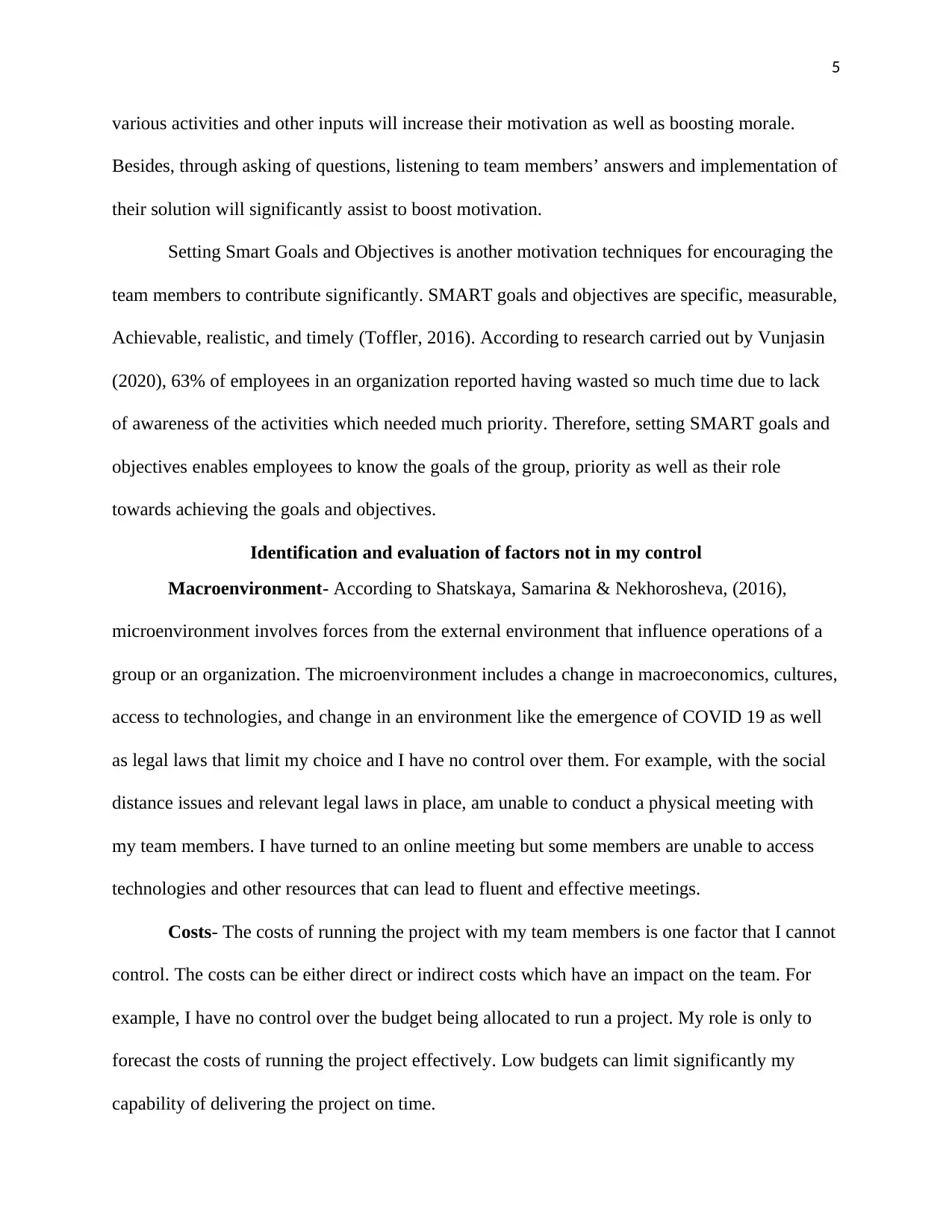
5
various activities and other inputs will increase their motivation as well as boosting morale.
Besides, through asking of questions, listening to team members’ answers and implementation of
their solution will significantly assist to boost motivation.
Setting Smart Goals and Objectives is another motivation techniques for encouraging the
team members to contribute significantly. SMART goals and objectives are specific, measurable,
Achievable, realistic, and timely (Toffler, 2016). According to research carried out by Vunjasin
(2020), 63% of employees in an organization reported having wasted so much time due to lack
of awareness of the activities which needed much priority. Therefore, setting SMART goals and
objectives enables employees to know the goals of the group, priority as well as their role
towards achieving the goals and objectives.
Identification and evaluation of factors not in my control
Macroenvironment- According to Shatskaya, Samarina & Nekhorosheva, (2016),
microenvironment involves forces from the external environment that influence operations of a
group or an organization. The microenvironment includes a change in macroeconomics, cultures,
access to technologies, and change in an environment like the emergence of COVID 19 as well
as legal laws that limit my choice and I have no control over them. For example, with the social
distance issues and relevant legal laws in place, am unable to conduct a physical meeting with
my team members. I have turned to an online meeting but some members are unable to access
technologies and other resources that can lead to fluent and effective meetings.
Costs- The costs of running the project with my team members is one factor that I cannot
control. The costs can be either direct or indirect costs which have an impact on the team. For
example, I have no control over the budget being allocated to run a project. My role is only to
forecast the costs of running the project effectively. Low budgets can limit significantly my
capability of delivering the project on time.
various activities and other inputs will increase their motivation as well as boosting morale.
Besides, through asking of questions, listening to team members’ answers and implementation of
their solution will significantly assist to boost motivation.
Setting Smart Goals and Objectives is another motivation techniques for encouraging the
team members to contribute significantly. SMART goals and objectives are specific, measurable,
Achievable, realistic, and timely (Toffler, 2016). According to research carried out by Vunjasin
(2020), 63% of employees in an organization reported having wasted so much time due to lack
of awareness of the activities which needed much priority. Therefore, setting SMART goals and
objectives enables employees to know the goals of the group, priority as well as their role
towards achieving the goals and objectives.
Identification and evaluation of factors not in my control
Macroenvironment- According to Shatskaya, Samarina & Nekhorosheva, (2016),
microenvironment involves forces from the external environment that influence operations of a
group or an organization. The microenvironment includes a change in macroeconomics, cultures,
access to technologies, and change in an environment like the emergence of COVID 19 as well
as legal laws that limit my choice and I have no control over them. For example, with the social
distance issues and relevant legal laws in place, am unable to conduct a physical meeting with
my team members. I have turned to an online meeting but some members are unable to access
technologies and other resources that can lead to fluent and effective meetings.
Costs- The costs of running the project with my team members is one factor that I cannot
control. The costs can be either direct or indirect costs which have an impact on the team. For
example, I have no control over the budget being allocated to run a project. My role is only to
forecast the costs of running the project effectively. Low budgets can limit significantly my
capability of delivering the project on time.
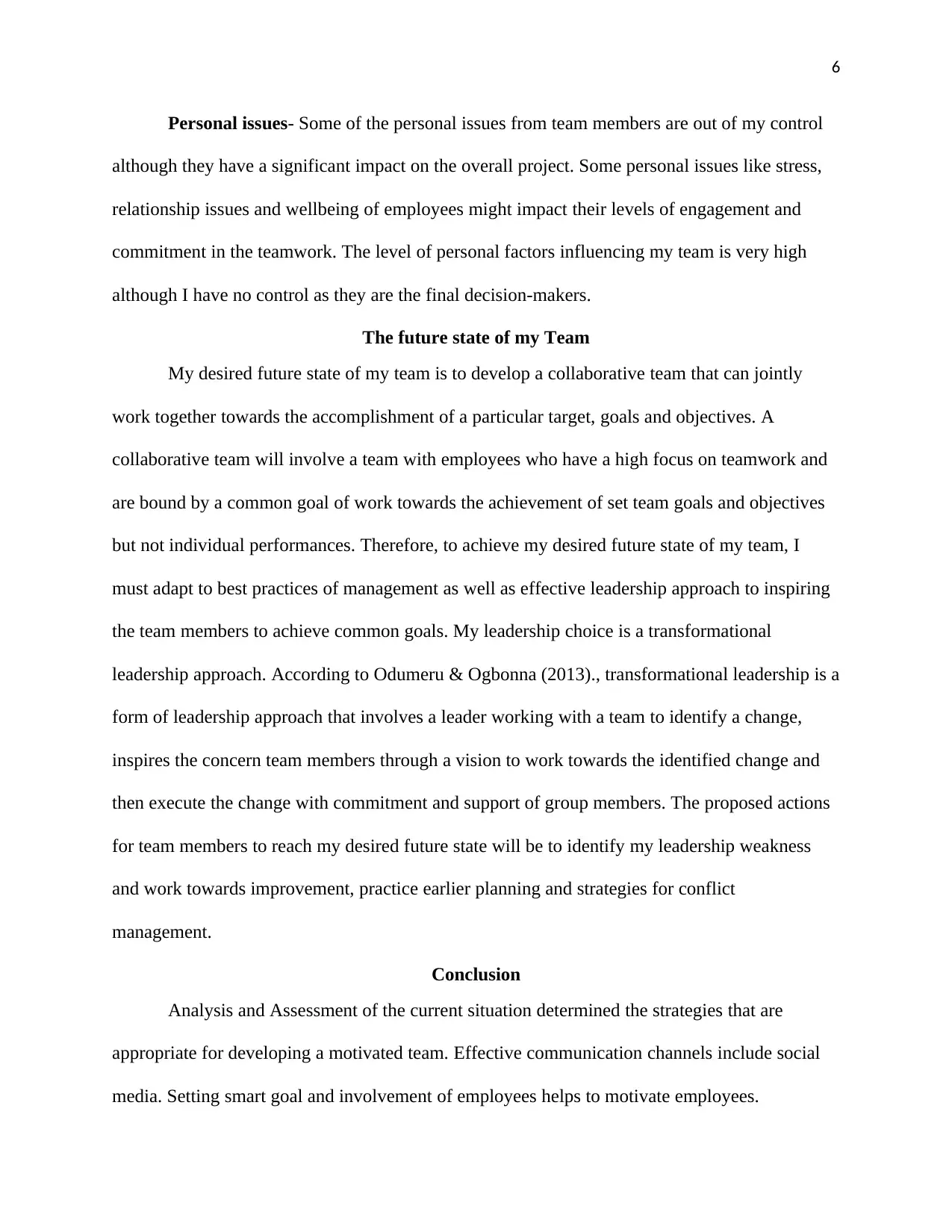
6
Personal issues- Some of the personal issues from team members are out of my control
although they have a significant impact on the overall project. Some personal issues like stress,
relationship issues and wellbeing of employees might impact their levels of engagement and
commitment in the teamwork. The level of personal factors influencing my team is very high
although I have no control as they are the final decision-makers.
The future state of my Team
My desired future state of my team is to develop a collaborative team that can jointly
work together towards the accomplishment of a particular target, goals and objectives. A
collaborative team will involve a team with employees who have a high focus on teamwork and
are bound by a common goal of work towards the achievement of set team goals and objectives
but not individual performances. Therefore, to achieve my desired future state of my team, I
must adapt to best practices of management as well as effective leadership approach to inspiring
the team members to achieve common goals. My leadership choice is a transformational
leadership approach. According to Odumeru & Ogbonna (2013)., transformational leadership is a
form of leadership approach that involves a leader working with a team to identify a change,
inspires the concern team members through a vision to work towards the identified change and
then execute the change with commitment and support of group members. The proposed actions
for team members to reach my desired future state will be to identify my leadership weakness
and work towards improvement, practice earlier planning and strategies for conflict
management.
Conclusion
Analysis and Assessment of the current situation determined the strategies that are
appropriate for developing a motivated team. Effective communication channels include social
media. Setting smart goal and involvement of employees helps to motivate employees.
Personal issues- Some of the personal issues from team members are out of my control
although they have a significant impact on the overall project. Some personal issues like stress,
relationship issues and wellbeing of employees might impact their levels of engagement and
commitment in the teamwork. The level of personal factors influencing my team is very high
although I have no control as they are the final decision-makers.
The future state of my Team
My desired future state of my team is to develop a collaborative team that can jointly
work together towards the accomplishment of a particular target, goals and objectives. A
collaborative team will involve a team with employees who have a high focus on teamwork and
are bound by a common goal of work towards the achievement of set team goals and objectives
but not individual performances. Therefore, to achieve my desired future state of my team, I
must adapt to best practices of management as well as effective leadership approach to inspiring
the team members to achieve common goals. My leadership choice is a transformational
leadership approach. According to Odumeru & Ogbonna (2013)., transformational leadership is a
form of leadership approach that involves a leader working with a team to identify a change,
inspires the concern team members through a vision to work towards the identified change and
then execute the change with commitment and support of group members. The proposed actions
for team members to reach my desired future state will be to identify my leadership weakness
and work towards improvement, practice earlier planning and strategies for conflict
management.
Conclusion
Analysis and Assessment of the current situation determined the strategies that are
appropriate for developing a motivated team. Effective communication channels include social
media. Setting smart goal and involvement of employees helps to motivate employees.
⊘ This is a preview!⊘
Do you want full access?
Subscribe today to unlock all pages.

Trusted by 1+ million students worldwide
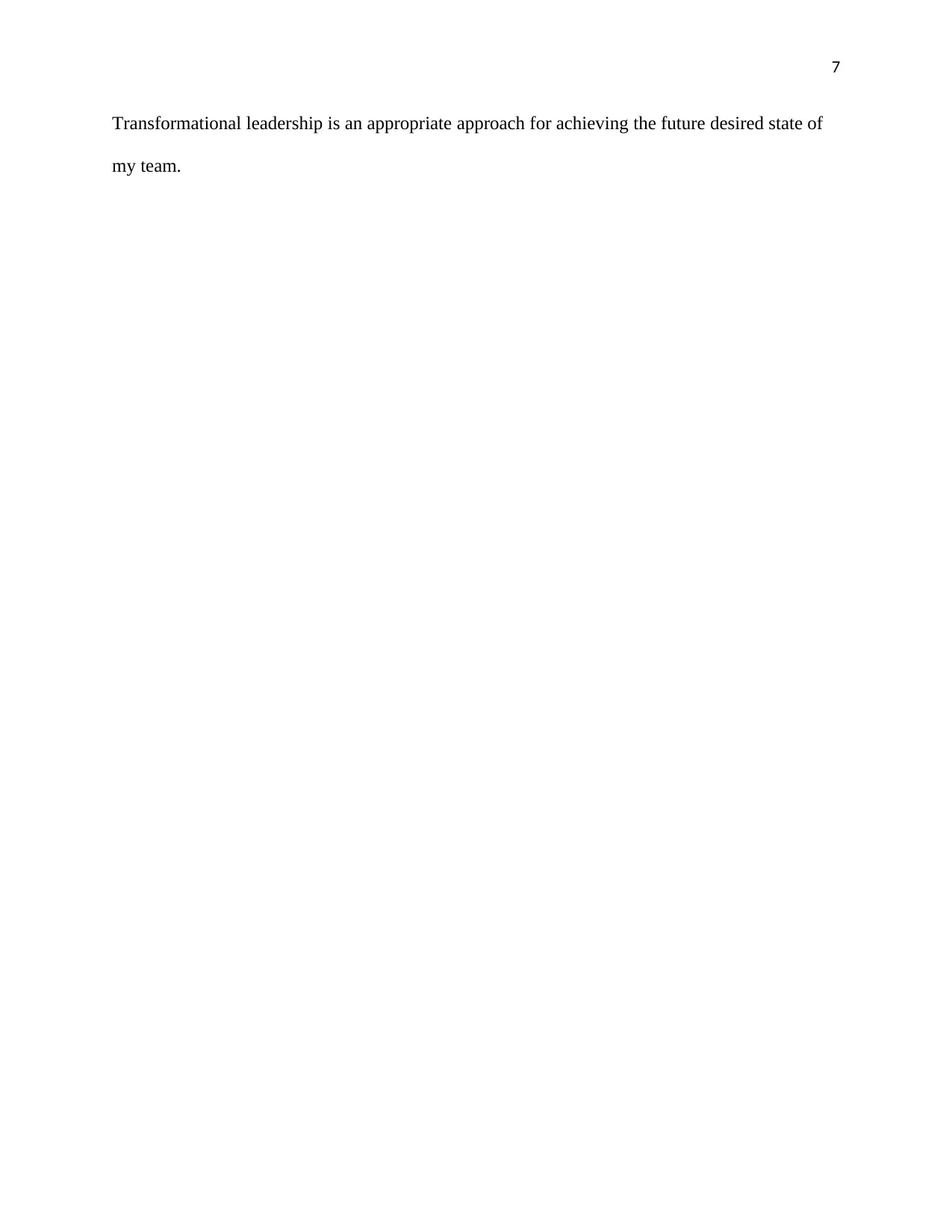
7
Transformational leadership is an appropriate approach for achieving the future desired state of
my team.
Transformational leadership is an appropriate approach for achieving the future desired state of
my team.
1 out of 7
Related Documents
Your All-in-One AI-Powered Toolkit for Academic Success.
+13062052269
info@desklib.com
Available 24*7 on WhatsApp / Email
![[object Object]](/_next/static/media/star-bottom.7253800d.svg)
Unlock your academic potential
Copyright © 2020–2025 A2Z Services. All Rights Reserved. Developed and managed by ZUCOL.





